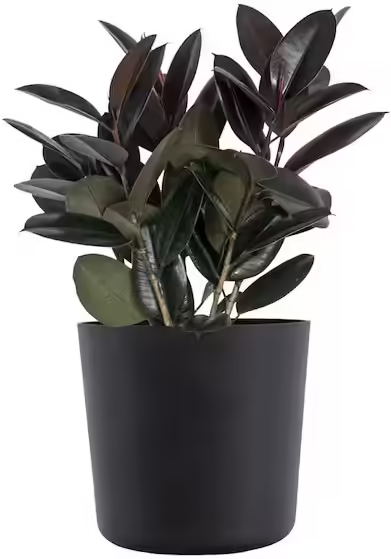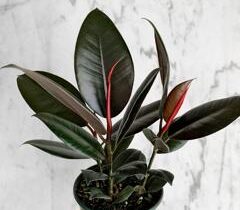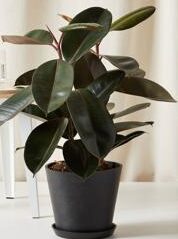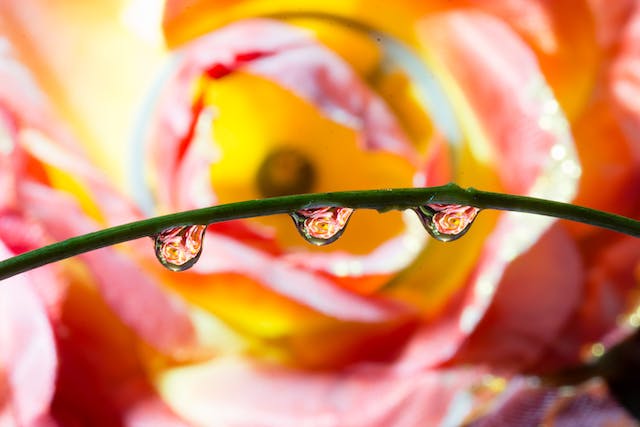How to Keep Your Ficus Burgundy Bush Happy and Healthy

Introduction
The Ficus Burgundy Bush is known as the Burgundy Rubber Tree (Ficus elastica ‘Burgundy’). It is a striking, sophisticated houseplant you can add to your indoor jungle. It has a glossy, impressive stature, and deep burgundy-colored leaves. This rubber tree has become popular among plant enthusiasts and interior designers.
The Ficus Burgundy Bush has stunning foliage. Its large, leathery leaves in deep shades of burgundy to almost black, catch the light. The leaves can grow up to 12 inches long. They create a display that can transform any space into a tropical paradise.
It is native to the tropical regions of Southeast Asia. The plant is common in India and Indonesia. The Burgundy Rubber Tree grows as a towering tree in the wild. This tree can reach heights of up to 100 feet. When grown indoors, this plant can be maintained at a manageable size. It’s perfect for creating dramatic vertical interest in your home. It can grow between 6 to 10 feet tall.
Understanding Your Ficus Burgundy Bush
Scientific Classification
The Ficus Burgundy Bush belongs to:
- Family: Moraceae
- Genus: Ficus
- Species: F. elastica
- Cultivar: ‘Burgundy’
Physical Characteristics
Height and Growth Patterns
- Indoor height: 6-10 feet when mature
- Growth rate: Moderate to fast during growing season
- Growth pattern: Upright and branching
- Can be trained to be bushier through proper pruning
- Adds 24-36 inches of height yearly in ideal conditions
Leaf Color and Texture
- New leaves emerge from rosy-red sheaths
- Mature leaves display deep burgundy to almost black coloring
- The upper surface is glossy and smooth
- Leaves are thick and leathery
- Size ranges from 5-12 inches long
- Oval to elliptical shape with a pointed tip
Stem Structure
- The main stem is thick and woody
- Young stems are green, turning brown as they mature
- Produces aerial roots when humidity is high
- Shows prominent leaf scars where old leaves have fallen
Root System
- Develops a robust root system
- The main roots are thick and fleshy
- Produces aerial roots that may need guidance
- Can become root-bound if not repotted
Different Varieties of Rubber Trees
While the Burgundy variety is dramatic, other popular rubber tree varieties include:
- Ficus elastica ‘Robusta’ – traditional green leaves
- Ficus elastica ‘Tineke’ – variegated green and cream
- Ficus elastica ‘Ruby’ – variegated with pink
- Ficus elastica ‘Decora’ – broad, dark green leaves
What Makes the Burgundy Variety Unique
Ficus Burgundy Bush stands out from other rubber tree varieties. It stands out due to several distinctive features:
- Deepest leaf coloration among rubber trees
- Superior glossiness compared to other varieties
- More compact growth habit
- Better tolerance for lower light conditions
- Stronger resistance to leaf spotting
- More dramatic visual impact in interior spaces

Essential Care Guide for Ficus Burgundy Bush
Light Requirements
To keep your Ficus Burgundy Bush thriving, understanding its light needs is crucial:
Optimal Light Conditions
- Bright, indirect light is ideal
- Can tolerate moderate light conditions
- Morning sun is beneficial
- Filter strong afternoon sun
- 6-8 hours of indirect light daily is optimal
Signs of Too Much Light
- Bleached or faded leaves
- Crispy brown edges
- Leaf curling
- Excessive leaf drop
Signs of Too Little Light
- Loss of deep burgundy color
- Smaller new leaves
- Leggy growth
- Slower growth
- Leaves dropping from lower branches
Best Placement in Your Home
- North or east-facing windows are ideal
- Several feet back from south or west windows
- Near bright windows with sheer curtains
- Away from heating/cooling vents
Seasonal Light Adjustments
- Move closer to windows in winter
- Provide extra shade in summer
- Rotate plant quarterly for even growth
- Adjust position based on seasonal sun patterns
Watering Frequency
- Water when the top 1-2 inches of soil feels dry
- Water every 7-10 days in the growing season
- Reduce frequency by 50% during winter months
- Always check soil moisture before watering
- Use the finger test: insert a finger up to the second knuckle
Signs of Overwatering
- Yellowing leaves throughout the plant
- Soft, mushy stems
- Water-soaked spots on leaves
- Moldy soil surface
- Foul smell from soil
- Root rot symptoms
Signs of Underwatering
- Crispy brown leaf edges
- Drooping or wilting leaves
- Leaf drop, especially lower leaves
- Dry, compacted soil
- Slow growth
- Wrinkled leaves
Water Quality Requirements
- Room temperature water only
- Avoid chlorinated water if possible
- Let tap water sit for 24 hours before using
- Filtered water is ideal
- Avoid softened water due to salt content
Humidity Needs and Management
- Prefer humidity levels of 40-60%
- Use a humidity tray with pebbles
- Mist leaves often in dry environments
- Group with other plants to increase humidity
- Consider using a humidifier in dry seasons
Soil and Fertilization
Best Soil Type for Ficus Burgundy Bush
- Well-draining potting mix
- Mix composition:
- 60% high-quality potting soil
- 20% perlite
- 20% orchid bark or coconut coir
- Add charcoal for improved drainage
- Avoid heavy, dense soils
- Commercial aroid mixes work well
Soil pH Requirements
- Optimal pH range: 6.0-6.5
- Can tolerate acidic conditions
- Test soil pH every 6 months
- Adjust pH with appropriate amendments
- Watch plant response to soil conditions
Fertilizer Recommendations
- Balanced NPK ratio (10-10-10)
- Use liquid fertilizer for even distribution
- Organic options:
- Fish emulsion
- Seaweed fertilizer
- Worm castings
- Synthetic options:
- Water-soluble complete fertilizer
- Slow-release granules
Feeding Schedule
- Feed every 4 weeks during growing season
- Reduce to every 8 weeks in winter
- Stop fertilizing for 2 months in late fall
- Resume feeding in early spring
- Adjust based on plant growth and health
Signs of Nutrient Deficiency
- Nitrogen deficiency: yellowing older leaves
- Phosphorus deficiency: purple leaf undersides
- Potassium deficiency: brown leaf edges
- Magnesium deficiency: yellowing between veins
- Iron deficiency: yellowing new growth

Temperature and Environment
Ideal Temperature Range
- Optimal daytime: 65-85°F (18-29°C)
- Optimal nighttime: 60-75°F (15-24°C)
- Minimum temperature: 55°F (13°C)
- Maximum temperature: 90°F (32°C)
- Avoid extreme temperature fluctuations
Temperature Fluctuation Tolerance
- Can handle ±5°F changes
- Protect from sudden drafts
- Move away from doors in winter
- Shield from AC vents
- Use thermal curtains if near windows
Draft Sensitivity
- Highly sensitive to cold drafts
- Keep away from:
- Air conditioning vents
- Heating vents
- Drafty windows
- Exterior doors
- Ceiling fans
- Use draft excluders when necessary
Best Rooms for Placement
- Living rooms with stable temperatures
- Home offices with a controlled environment
- Bedrooms away from drafts
- Avoid:
- Kitchens (temperature fluctuations)
- Bathrooms (unless well-ventilated)
- Sunrooms (temperature extremes)
- Entranceways
- Unheated spaces
Growth and Maintenance
Pruning and Shaping
Proper pruning is essential to maintaining your Ficus Burgundy Bush’s appearance and health:
When to Prune
- Early spring is ideal for major pruning
- Remove dead or yellowing leaves year-round
- Trim growth tips to encourage bushiness
- Prune leggy growth as needed
- Plan heavy pruning before growth season
Proper Pruning Techniques
- Use clean, sharp pruning shears
- Cut at 45-degree angles
- Make cuts above leaf nodes
- Remove no more than 25% at once
- Handle latex sap with care (wear gloves)
Propagation Methods
The Ficus Burgundy Bush is propagated using several methods. The most reliable is air layering and stem cuttings.
Step-by-Step Propagation Guide
Water Propagation
- Select a healthy stem with 2-3 leaves
- Cut below a node at a 45-degree angle
- Remove lower leaves, keeping 1-2 at top
- Place in clean water
- Change water every 3-4 days
- Wait for roots to develop (4-8 weeks)
- Transfer to soil when roots are 2-3 inches long
Air Layering
- Choose a healthy stem section
- Make a small incision in the bark
- Apply rooting hormone
- Wrap with damp sphagnum moss
- Cover with plastic wrap
- Secure ends with plant tape
- Wait 4-6 weeks for roots
- Cut below new roots and pot
Best Time to Propagate
- Early spring to early summer
- When the plant is growing
- Avoid winter propagation
- Temperature should be 70-80°F (21-27°C)
- Humidity should be 60% or higher
Common Propagation Mistakes
- Cutting pieces too small
- Using unhealthy parent plant
- Incorrect cutting angle
- Not using clean tools
- Overwatering new plants
- Insufficient humidity
- Rushing the process
Success Tips
- Use rooting hormone for better results
- Maintain warm temperatures
- Provide bright, indirect light
- Keep cutting medium moist
- Be patient – roots take time
- Use clear containers to check root growth

Common Problems and Solutions
Pest Management
Common Pests Affecting Ficus Burgundy Bush
- Spider mites
- Signs: fine webbing, stippled leaves
- Treatment: neem oil, insecticidal soap
- Prevention: maintain humidity, regular inspection
- Mealybugs
- Signs: white cottony masses
- Treatment: alcohol swabs, systemic insecticide
- Prevention: quarantine new plants, good air circulation
- Scale insects
- Signs: brown bumps on stems/leaves
- Treatment: manual removal, horticultural oil
- Prevention: regular inspection, clean leaves
- Thrips
- Signs: silvery streaks, distorted growth
- Treatment: blue sticky traps, spinosad
- Prevention: regular monitoring, proper spacing
Prevention Methods
- Regular inspection of leaves and stems
- Maintain proper growing conditions
- Quarantine new plants for 2-3 weeks
- Clean leaves monthly
- Good air circulation
- Proper watering practices
Treatment Options
- Natural Solutions:
- Neem oil spray
- Insecticidal soap
- Diatomaceous earth
- Beneficial insects
- Horticultural oils
- Chemical Solutions:
- Systemic insecticides
- Contact insecticides
- Growth regulators
- Miticides for spider mites
- Appropriate chemical rotation
Troubleshooting Common Issues
Leaf Dropping
- Causes:
- Sudden temperature changes
- Overwatering
- Underwatering
- Low light
- Pest infestation
- Solutions:
- Stabilize environment
- Adjust watering routine
- Increase light if needed
- Check for pests
- Maintain consistent care
Yellow Leaves
- Causes:
- Overwatering
- Nutrient deficiency
- Poor drainage
- Root problems
- Insufficient light
- Solutions:
- Check soil moisture
- Improve drainage
- Adjust fertilization
- Increase light exposure
- Repot if necessary
Brown Spots
- Causes:
- Sunburn
- Bacterial infection
- Physical damage
- Chemical burn
- Water spots
- Solutions:
- Adjust light exposure
- Remove affected leaves
- Use appropriate water
- Avoid leaf wetness
- Improve air circulation
Advanced Care Tips
Air Purification Benefits
- Removes formaldehyde
- Filters indoor air pollutants
- Increases oxygen levels
- Reduces airborne particles
- Improves indoor air quality
Training and Shaping Techniques
- Staking for upright growth
- Pinching for bushiness
- Regular rotation
- Strategic pruning
- Using support poles
Long-term Maintenance Strategies
- Annual repotting schedule
- Seasonal care adjustments
- Regular cleaning routine
- Growth monitoring
- Preventive pest management
FAQs About Ficus Burgundy Bush
How fast does a Burgundy Rubber Tree grow? A healthy Ficus Burgundy Bush grows 24-36 inches annually under optimal conditions. Growth is most during spring and summer months, with slower growth during fall and winter.
Can it grow outdoors? The Ficus Burgundy Bush can grown outdoors only in USDA zones 10-12. It requires temperatures above 55°F (13°C). It should be shielded from direct sunlight and strong winds.
Is it toxic to pets? Yes, the Ficus Burgundy Bush is toxic to cats and dogs. The sap compounds cause oral irritation, drooling, and digestive upset if ingested. Keep the plant out of reach of pets.
Why are the leaves dropping? Leaf drop is often a response to environmental stress. Common causes include:
- Changes in temperature or lighting
- Improper watering (too much or too little)
- Low humidity
- Pest infestation
- Recent relocation
How to clean the leaves? Clean leaves monthly using:
- Lukewarm water and soft cloth
- Diluted neem oil solution
- Commercial leaf shine product
- Avoid using milk or oil-based products
- Gentle wiping motion from base to tip
Can it be grown as a bonsai? Yes, the Ficus Burgundy Bush can be grown as a bonsai. It will need patience and proper techniques. Start with a young plant and use regular pruning, wiring, and root maintenance.

Conclusion
Growing a Ficus Burgundy Bush requires attention to detail and consistent care. The rewards are well worth the effort. Remember these key points:
- Provide bright, indirect light
- Maintain a proper watering schedule
- Check humidity levels
- Regular inspection for pests
- Consistent feeding during growing season
